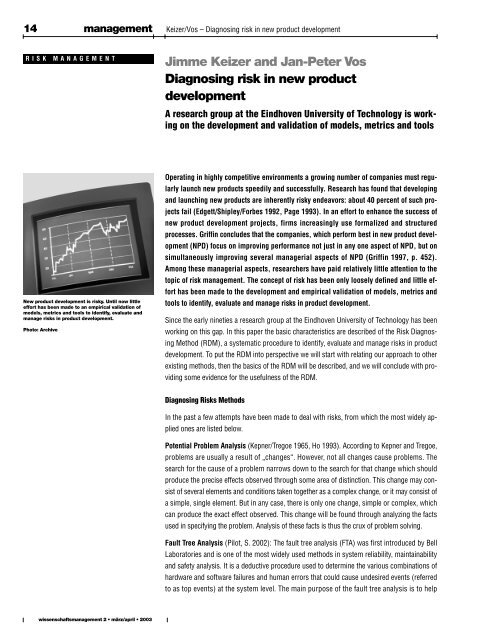Heft 2/2003 - Lemmens Medien GmbH
Heft 2/2003 - Lemmens Medien GmbH
Heft 2/2003 - Lemmens Medien GmbH
Erfolgreiche ePaper selbst erstellen
Machen Sie aus Ihren PDF Publikationen ein blätterbares Flipbook mit unserer einzigartigen Google optimierten e-Paper Software.
14 management Keizer/Vos – Diagnosing risk in new product development<br />
RISK MANAGEMENT<br />
New product development is risky. Until now little<br />
effort has been made to an empirical validation of<br />
models, metrics and tools to identify, evaluate and<br />
manage risks in product development.<br />
Photo: Archive<br />
wissenschaftsmanagement 2 • märz/april • <strong>2003</strong><br />
Jimme Keizer and Jan-Peter Vos<br />
Diagnosing risk in new product<br />
development<br />
A research group at the Eindhoven University of Technology is working<br />
on the development and validation of models, metrics and tools<br />
Operating in highly competitive environments a growing number of companies must regularly<br />
launch new products speedily and successfully. Research has found that developing<br />
and launching new products are inherently risky endeavors: about 40 percent of such projects<br />
fail (Edgett/Shipley/Forbes 1992, Page 1993). In an effort to enhance the success of<br />
new product development projects, firms increasingly use formalized and structured<br />
processes. Griffin concludes that the companies, which perform best in new product development<br />
(NPD) focus on improving performance not just in any one aspect of NPD, but on<br />
simultaneously improving several managerial aspects of NPD (Griffin 1997, p. 452).<br />
Among these managerial aspects, researchers have paid relatively little attention to the<br />
topic of risk management. The concept of risk has been only loosely defined and little effort<br />
has been made to the development and empirical validation of models, metrics and<br />
tools to identify, evaluate and manage risks in product development.<br />
Since the early nineties a research group at the Eindhoven University of Technology has been<br />
working on this gap. In this paper the basic characteristics are described of the Risk Diagnosing<br />
Method (RDM), a systematic procedure to identify, evaluate and manage risks in product<br />
development. To put the RDM into perspective we will start with relating our approach to other<br />
existing methods, then the basics of the RDM will be described, and we will conclude with providing<br />
some evidence for the usefulness of the RDM.<br />
Diagnosing Risks Methods<br />
In the past a few attempts have been made to deal with risks, from which the most widely applied<br />
ones are listed below.<br />
Potential Problem Analysis (Kepner/Tregoe 1965, Ho 1993). According to Kepner and Tregoe,<br />
problems are usually a result of „changes“. However, not all changes cause problems. The<br />
search for the cause of a problem narrows down to the search for that change which should<br />
produce the precise effects observed through some area of distinction. This change may consist<br />
of several elements and conditions taken together as a complex change, or it may consist of<br />
a simple, single element. But in any case, there is only one change, simple or complex, which<br />
can produce the exact effect observed. This change will be found through analyzing the facts<br />
used in specifying the problem. Analysis of these facts is thus the crux of problem solving.<br />
Fault Tree Analysis (Pilot, S. 2002): The fault tree analysis (FTA) was first introduced by Bell<br />
Laboratories and is one of the most widely used methods in system reliability, maintainability<br />
and safety analysis. It is a deductive procedure used to determine the various combinations of<br />
hardware and software failures and human errors that could cause undesired events (referred<br />
to as top events) at the system level. The main purpose of the fault tree analysis is to help

















